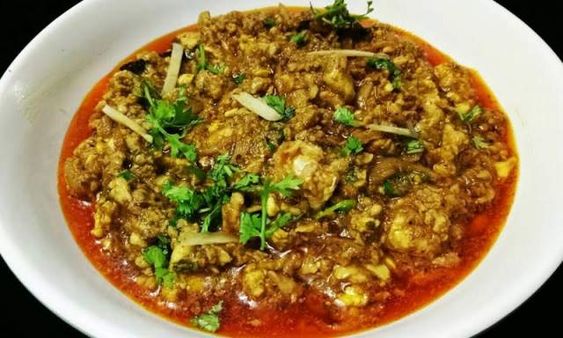
My grandparents, who hailed from the state of Sindh, in present-day Pakistan, were refugees living on railway platforms and in camps for some time after Partition and before their settlement in Pune.
By Pooja Makhijani
I was nine years old when I first ate goat brains for breakfast. It was the summer of 1987 and my family and I were in Pune, a then-small city near Mumbai where my maternal grandparents had migrated to from Pakistan after the 1947 partitioning of the British Indian Empire, and where my parents were born. My grandparents’ one-bedroom apartment, atop two steep flights of stairs, became home for several months, and we—my parents, my younger brother, and I—adjusted to the pace of life, albeit temporarily, of this quiet, quirky city.
Nani, my maternal grandmother, allowed me a shelf in her almirah—her sturdy steel cupboard—for my art supplies and my comic books, and I arranged and rearranged my colored pencils and paintbrushes as she used the almirah door mirror to adjust the drapes of her pale yellow sari and sweep her long white hair into an elegant chignon. She shooed me to the dining table while she went to her narrow galley kitchen to prepare our breakfast. At this hour, the Shi’a mosque next door called to prayer and rickshaws whirred and swerved and honked through the apartment complex, picking up children and taking them to school. From the balcony adjacent to the dining table, I saw the clock on the obelisk on the synagogue at the corner strike 7 a.m. and a herd of buffalo grazing in a small patch of grass near the complex’s water tower.
Like many other Hindu Sindhis of their generation, they clung to their traditional foodways, which included many organ meat preparations, including magaz, jerandi (goat liver), and bhukiyoo (goat kidney).
Nani placed magaz masala, or goat brains, seasoned with black pepper and garam masala and garnished with chilies and cilantro on the table, along with freshly made phulka, unleavened whole-wheat flatbread. I poured myself a cup of Tang, and forked the brains around my plate before shoving them into my mouth. They tasted similar to the masala-laced scrambled eggs that I often ate in my New Jersey home, but squishier and more unctuous.
My mother told me that magaz were a treat for her and her sisters; offal was cheaper than other cuts of meat. My grandparents, who hailed from the state of Sindh, in present-day Pakistan, were refugees living on railway platforms and in camps for some time after Partition and before their settlement in Pune. Like many other Hindu Sindhis of their generation, they clung to their traditional foodways, which included many organ meat preparations, including magaz, jerandi (goat liver), and bhukiyoo (goat kidney).Though my mother ate skewered kidneys grilled over hot coals or kidneys and liver prepared in a yogurt-based curry, we never had any of these, or goat brains for breakfast, once we returned home to the United States that August. Like other children of our age, we ate cold cereal in milk or toast.
Earlier this year, James Beard-nominated Pondicheri, a Houston-based restaurant and bake shop, opened their New York City outpost in the Flatiron District. The breakfast menu, served starting at 7 a.m. in its airy café section, has bheja masala, or goat brains sautéed with keema, cilantro, and spices. (Bheja is the Hindi word for “brain”; magaz, the Sindhi.) This was a pleasant surprise, until I discovered owner and Chef Asha Jaisinghani was also Sindhi (as was evident to me by her surname).
Nani turned vegetarian later in life (as had much of my immediate family) and turned away from the non-vegetarian delicacies of her ancestral cuisine, and we never had magaz again for breakfast on our subsequent trips to India.
“I was ostracized for my family’s foods growing up [in Gujarat, India],” Jaisinghani said. “Sindhi food was never on restaurant menus. It was a cuisine that I wasn’t proud of.” Now, traces of of her family’s dishes can be found everywhere on her award-winning restaurant menus (see: her Sindhi ladoos, a ball-shaped sweet made from wheat flour, sugar, and ghee, garnished with poppy seeds and pistachios), and it was important to her to incorporate the flavors of this little-known cuisine into her repertoire. “I love savory Indian breakfasts, and bheja fry is a personal favorite,” she said. She conceded that brains are an acquired taste, but that her Sindhi patrons devour it.
As an adult, I appreciated Jaisinghani’s concoctions’ buttery richness, silky, tofu-like texture, and perfect balance of savory and sweet—her dish is served with a pumpkin bun—but it didn’t quite match my grandmother’s more basic recipe. Something was missing, for me, in this perfectly-executed, beautifully-plated breakfast plate in New York City.
Nani turned vegetarian later in life (as had much of my immediate family) and turned away from the non-vegetarian delicacies of her ancestral cuisine, and we never had magaz again for breakfast on our subsequent trips to India. Pune changed dramatically as well; dozens of new bridges now cross the Mula-Mutha River, which flows through the city, and the place that was once known as a “pensioner’s paradise” is now dotted with malls and multiplexes.
Nani passed away several weeks ago and it is unlikely I will ever return to that second-floor apartment. But I can still taste her magaz masala—piquant and creamy—and see her toss leftover, stale phulkas to the crows perched on the grills of her kitchen window.
___________________
Courtesy: My Recipes (Published on February 13, 2018)